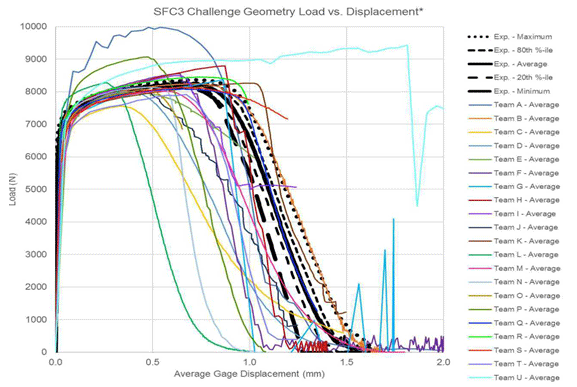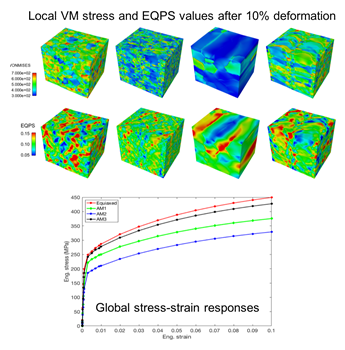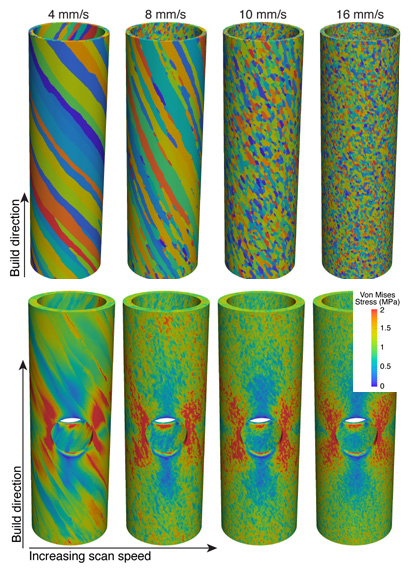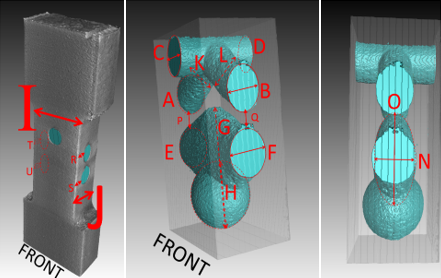The microstructures and properties of AM metals are unlike those of traditional wrought or cast metals. A high degree of variability has also been observed in the properties of many additive metals. To ensure that systems leveraging AM meet stringent reliability requirements for extreme environments, Sandia is using extensive materials testing, characterization, and modeling to build a property database for select AM metals and to improve fundamental understanding of process-microstructure-property-performance relationships. Novel metal alloys and polymers for AM are also being explored to address limitations inherent in conventional materials.
Testing and Characterization Capabilities
Sandia has world-class capabilities and expertise in materials testing and characterization. Some example capabilities include:
- Environmental testing (e.g., impact tests, thermal tests, etc.)
- Custom-built, automated, high-throughput tensile testing systems
- Latest generation computer tomography systems
- Modular, customizable, robotic testing, characterization, and post-processing system (Alinstante)
Impact testing

In this impact test of a hollow metal housing, the one-piece AM design on the right is both lighter and stronger than the conventional two-piece machined and welded design on the left.
High-throughput tensile testing
To rapidly and inexpensively generate a statistically meaningful database for AM metal properties, Sandia created a unique, automated, high-throughput tensile testing system capable of testing approximately 100 samples/hour.

Computer tomography
Computer tomography (CT) imaging of porosity in the gauge section of an AM printed "dog bone" tensile sample.
Alinstante
Microstructure and Performance
Stochastic Parallel PARticle Kinetic Simulator ( SPPARKS) is a parallel Monte Carlo code for on-lattice and off-lattice models that includes algorithms for kinetic Monte Carlo (KMC), rejection kinetic Monte Carlo (rKMC), and Metropolis Monte Carlo (MMC). Synthetic SPPARKS microstructures can be used in simulations of mechanical behavior (such as Sierra/Solid Mechanics) to simulate the impact of AM processing methods on performance. Microstructures have been used in simulations of both elastic and plastic deformation regimes. Crystallographic textures can be predicted within SPPARKS or applied from experimental distributions.
Crystal Plasticity Simulations of AM Representative Volume Elements



Sandia Fracture Challenge
The annual Sandia Fracture Challenge provides the international computational mechanics community an open forum for assessing its ability to predict ductile fracture through a blind, round-robin format where volunteer teams are asked to predict the deformation and failure of an arbitrary geometry given experimental calibration data. The Third Sandia Fracture Challenge (SFC3), issued in 2017, consisted of an additively manufactured 316L stainless steel tensile bar with through holes and internal cavities that could not have been conventionally machined. The 21 volunteer prediction teams were provided extensive materials data ranging from tensile tests of specimens printed on the same build tray to electron backscatter diffraction microstructural maps and micro-computed tomography scans of the Challenge geometry. The teams were asked a variety of questions, including predictions of variability in the resulting fracture response, as the basis for assessment of their predictive capabilities. A key purposes of this challenge was to determine what information about AM parts is necessary to accurately predict performance.

